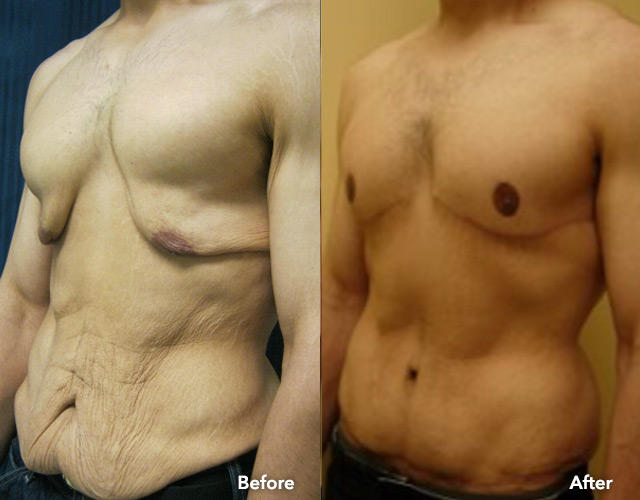Body Lift
A body lift, or belt lipectomy, is sometimes known as a lower body lift. This procedure removes excess sagging skin and fat from the lower abdomen, hips and lower back to create an improved profile and shape that is tighter and more attractive. Removing this excess tissue, which can weigh several pounds, may add to further weight loss. Our surgeons use this contouring procedure to help restore a smoother, firmer, better shaped abdomen, hips, and lower back and improve the appearance of thighs and buttocks.
Before and After Photos


The Procedure
A body lift, also sometimes known as a lower body lift, is a procedure in which excess sagging skin and fat from the lower abdomen, hips and lower back is removed to help create an improved profile and shape that is tighter and more attractive.
It is not a weight loss technique; however, the tissue removed may weigh several pounds. Instead, it is a contouring procedure that your Kaiser Permanente plastic surgeon performs to help restore a smoother, firmer, better shaped abdomen, hips and lower back. This procedure also improves the thighs and buttocks.
Your Kaiser Permanente plastic surgeon will perform this procedure in a certified operating suite under general anesthesia. The incision length and pattern are unique to every patient, but in general, a complete lower body lift requires a circumferential incision around the body at the level of the waist. Through this incision, an apron of excess skin and fat is removed and the remaining skin and tissues are repositioned in a lifted, smoother, tighter manner.
The exact incisions necessary will be discussed with you in detail at your consultation with your plastic surgeon. Liposuction is frequently added as an additional part of surgical body lifts to help further improve shape and contour. Occasionally, a lower body lift may be discussed in place of a thigh lift or as a complementary procedure. Your Kaiser Permanente plastic surgeon will walk you through the various options. Many of these procedures may be safely performed in combination.
Preparation
Your Kaiser Permanente plastic surgeon will work closely with you. Be prepared to discuss your expectations and desired outcome. Make sure to address all of your questions and concerns.
Aspirin, Motrin, non-steroidal anti-inflammatory medications, and some over-the-counter herbal medications must be discontinued at least two weeks prior to surgery. These and other drugs and substances may cause excess bleeding and bruising. You can usually begin taking them again after a week or so.
If you are a smoker, it is important to quit at least four weeks prior to surgery and refrain from smoking until four weeks after surgery to ensure your wounds heal properly. Your plastic surgeon will discuss this in detail with you and you will also be given a sheet with a list of common medicines to avoid for a short period. Your plastic surgeon will detail the risks associated with surgery. Plan to have a family member or friend drive you to and from your surgery appointment and stay with you for at least one night following surgery.
Recovery
Following your surgery, elastic bandages or compression garments will be used to cover your incisions and the areas treated. This will minimize swelling and to support your chest as it heals. Small tubes may be temporarily placed under the skin to drain excess fluid or blood that may collect.
The immediate recovery will depend upon what type of anesthesia that your Kaiser Permanente plastic surgeon will employ for the surgery. Various anesthetic agents affect patients differently and will dictate the patient’s recovery. Most surgeons will incorporate extensive local anesthesia into the tissues which can allow patients to wake up pain free. The local anesthesia will begin to wear off in three to four hours and most patients will experience mild to moderate discomfort at this stage. Pain is usually well controlled with pain medication prescribed by your doctor.
You will be given specific instructions on how to care of your incisions and drains, including any medications that you may need to take. We will arrange for your follow-up visit at our Kaiser Permanente office. Drains are typically removed after one to two weeks. For most plastic surgeries, there are no sutures to remove. It is most common to use absorbable sutures which melt on their own within a few months. You can shower the day after your procedure but should stay out of the ocean or pool for 2-3 weeks, or until your drain has been removed.
It is important to avoid strenuous activity for two to three weeks after surgery to avoid bleeding and other complications. One of the potential risks of surgery is infection and this usually manifests itself around five to seven days after surgery and is usually effectively treated with oral antibiotics. Numbness around the incisions is normal after surgery and can persist for several months.
Healing time is variable. A significant amount of the recovery occurs within 2-3 months; but it will take the external scar a year to soften/mature and the internal tissues undergo similar softening. For breast implants, the full recovery period is at least a year and this involves a gradual softening of the tissues around the implant and time for it to settle into its natural position

